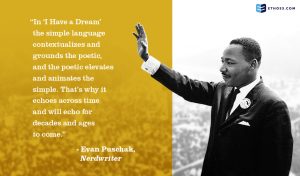How did Martin Luther King Jr. write his “I Have a Dream” speech? The speech is regarded as one of the greatest speeches in American history and came at the height of the Civil Rights movement. But how did Dr. King construct this legendary moment? Why does it still stand the test of time? In his Nerdwriter series, Evan Puschak deconstructs the speech by recognizing literary devices used throughout it.
Anaphora:
This technique is the repetition of a word or phrase at the beginning of a series of clauses. Dr. King uses this to emphasize his ideas on where African Americans have been in this country, and where he hopes the future will take them. This is a way he organized the speech to take his audience from the past, to the present, and to the future.
“One hundred years later…” is repeated 4 times.
“Now is the time…” is repeated 4 times.
“We cannot be satisfied…” is repeated 4 times.
“I have a dream…” is repeated 5 times.
Read more: Repetition is a Beautiful Thing
Alliteration:
Dr. King grew up singing in choir at his church, and went on to become a Baptist minister. You can hear a lyrical flow in this speech, one he developed from his years in the church. He constructs many of his phrases using alliteration, where similar sounds or letters fall closely to each other.
“The dark and desolate valley…”
“The marvelous new militancy…”
“Great trials and tribulations…”
Allusion:
Dr. King uses a combination of inspiration from other pieces of literature and cliches. Like the video points out, Dr. King rewrites a verse from Shakespeare to fit the black experience in America. Or how he begins his speech much like Abraham Lincoln’s Emancipation Proclamation.
“Five score years ago, a great American in whose symbolic shadow we stand today…”

The literary devices used in “I Have A Dream” can be used in your presentation. Repetition can be an impactful way to share your message. Creating a rhythmic or poetic flow will help your presentation stand out. And drawing inspiration from other great writers will amplify your own writing. Give these methods a try when you begin working on your next presentation. The outcome could be timeless.
Related Posts:
Lessons from History: MLK Jr.’s “I Have a Dream”